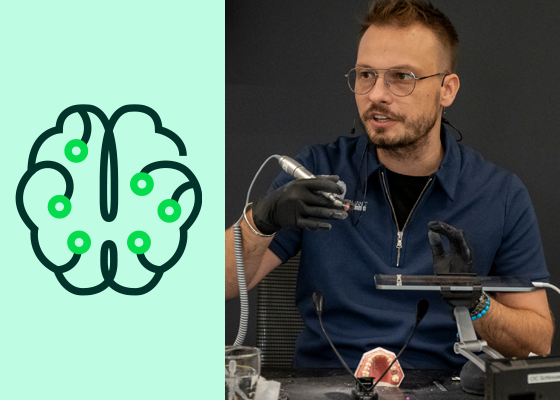What is the name of the patron saint of dentists?
Brain of the Week – History


Do you know what factors may be contributing to your patients’ caries risk? Learn what you might be missing and how to provide more personalized care.
Classification of patients into low, medium and high caries risk categories is helpful for determining the frequency at which patients return for hygiene recalls or receive bitewing radiographs. In order to manage a high caries risk patient, however, determining the specific risk factors to that patient is the critical step to their non-surgical management. For example, a young patient with an abundance of saliva but a preference for nighttime snacking instead of toothbrushing will require different management than an older patient on multiple medications causing xerostomia. As there is so much variation in the lifestyles and habits of our patients that can affect their propensity for developing carious lesions, establishing a framework to organize different categories of high risks patients can simplify the process of identifying and managing high risk behaviors. Simplifying this process for the clinician is aimed to make non-surgical treatment of caries practical and commonplace in the clinic. The suggested categorization framework includes 4 general types of high caries risk patients: low salivary flow, poor diet, poor hygiene, and low fluoride exposure. Each category of high caries risk will be discussed individually.

Saliva has many functions. Patients appreciate saliva for its function to lubricate the mouth and assist with taste. From the standpoint of caries prevention, its two most important functions are to provide a bicarbonate buffer and act as a reservoir for the mineral content that is dissolved from tooth structure during the demineralization process of caries. In order to treat patients with a low salivary output, the clinician must first determine the cause of the low output. Saliva originates from the major glands (parotid, submandibular, and sublingual) as well as minor salivary glands. If salivary output from the glands is decreased due to medications such as antihypertensives, antidepressants, analgesics, tranquilizers, diuretics, and antihistamines, then the patient may be able to use treatment which stimulates the release of additional saliva. If the salivary glands are non-functional, as may be the result of head and neck radiation therapy or from Sjogrens syndrome (an auto-immune disorder of the salivary glands), then the patient may only be left with the option to artificially replace saliva.

Stimulation of saliva may be achieved by chewing gums, lozenges or mints. If a patient is advised to use one of these methods to stimulate saliva flow, a sugar-free or non-fermentable sugar (such as xylitol) containing product should be recommended. Another option to stimulate saliva flow is to use pharmacological agents, such as a parasympathetic agonist.
If salivary stimulation is not possible, then salivary replacement may be necessary. Several formulations of xerostomia rinses, gels, and sprays are available. Often the patient may need to try several formulations to find one to fit their individual preference. The rinses may be used in the morning while the more viscous gels are recommended for nighttime use, and the sprays throughout the day. And because some sprays contain lubricants as well as buffers, they work well to help replace bicarbonate. For patients who are unable or unwilling to purchase a salivary substitute, a spray bottle or drinking bottle containing water may be used to hydrate and neutralize the mouth. For additional acid neutralization, the patient may add baking soda (bicarbonate) to their water (about 1 cup of water with ¼ teaspoon of baking soda).
Saliva acts as a reservoir for mineral content lost on teeth during the demineralization process of caries in order that it be reabsorbed during periods of remineralization. Therefore, patients with low salivary output should be exposed to additional fluoride (high fluoride toothpaste, fluoride rinse) in order to saturate their saliva with fluoride ions or be placed on a regular in-office fluoride regimen to provide increased exposure time to topical fluoride.
Dietary habits of patients may be a large contributor to caries. The method of treatment for a patient with this risk factor is patient education. There are two concepts that are taught as basic concepts in cariology to dental professionals but are foreign to many laypersons outside of dentistry. The first concept is the origin of caries as demonstrated by the Keyes diagram. This concept explains that carious lesions only occur when fermentable sugars are converted by bacteria into acid, causing demineralization of a tooth substrate. Many patients have no idea that it is actually acid which causes “cavities”, not sugar alone. The second concept is demonstrated by the Stephan Curve which shows the pH drop within dental plaque immediately following exposure to sugar and the subsequent increase in pH after neutralization from salivary buffers. The educational message for patients is that it is the frequency of sugar consumption that determines their caries activity. If the patient replenishes the sugar supply to the acid-producing bacteria prior to salivary buffering, the patient will remain in a constant state of demineralization.

Practically, there are two common dietary behaviors that lead to increased caries risk: frequent consumption of sugary snacks and frequent consumption of sodas or juices. For patients that have access to candies or snacks that are eaten throughout the day, education about the dangers of frequent sugar consumption should be explained in a way which resonates with the patient. Education about the types of snacks which have an increased risk of remaining in the mouth for a prolonged period of time include hard candies which may be kept in the mouth until they are dissolved or sticky candies which may be lodged into embrasure spaces or within occlusal grooves. Another strategy would be to encourage the patient to replace the sugar-containing snacks with those which contain sugar alcohols (xylitol, erythritol, sorbitol) or non-caloric sweeteners (aspartame, sucralose) as these sugars are not fermentable by acid-producing bacteria and therefore will not cause carious lesions. One common question from patients is whether eating sweet fruits may cause “cavities”. Although eating fruit is preferred over candy since fruit has nutritive value and it is often less sticky than candy, fruit contains fermentable sugars which may cause carious lesions.

The other potentially more dangerous dietary behavior is frequent consumption of sweetened beverages. Sweetened beverages are often detrimental to tooth structure as they not only provide fermentable sugar for acid-producing bacteria, but the acidity of the beverage itself is at a pH below the critical pH for dissolving dental enamel and cementum. The critical pH to dissolve cementum is 6.5 and enamel is 5.5. The pH of many sodas is around 2.5 while the pH of battery acid is around 1. Many patients will assume that drinking a diet soda cannot cause cavities as it does not contain fermentable sugar. However, the pH of diet soda is very similar to non-diet soda. In fact, many carbonated water drinks have a pH below 5.5. Patients who drink these beverages should be encouraged to at least rinse their mouth with water following consumption of an acidic beverage in order to neutralize the pH of their mouth.
Oral acidity may come from several other sources such as chlorinated swimming pool water and gastric acid experienced in patients with gastric reflux or bulimia. If suspected, the dental implications of these conditions or behaviors should be explained to patient.
![]()
Removal of plaque is necessary in order to prevent carious lesions. Patients with poor oral hygiene may be evident through self-admission of the patient or more commonly through observation of plaque on tooth surfaces. Clinicians may have the temptation to suspect dishonesty from patients who report frequent home hygiene practices but present with visible plaque. However, some patients are unaware of the location of plaque on their tooth surfaces (often at the cervical margin) and demonstration of the plaque with a disclosing agent may allow the patient to improve hygiene methods. Other patients may simply require additional motivation or incentive to improve home hygiene. Introducing patients to new tools, such as electric toothbrushes or floss-aids may motivate the patient to improve home practices.
Other patients have limitations that prevent adequate home oral hygiene. Patients with appliances or fixed prosthesis may not know how to properly clean their dental appliances. Floss threaders, superfloss, soft picks, or other tools may assist with cleaning. Also, all patients who are undergoing orthodontic treatment will inherently have an increased risk of developing caries. The occurrence of white spot lesions surrounding the location of a former brackets can blight the positive esthetic and functional outcomes of orthodontic treatment. Orthodontic patients should be instructed on the methods to clean adjacent to brackets as well as interproximally underneath their wires. Additionally, additional fluoride treatments may be considered for these patients.
There may also be patients who are limited in their home oral hygiene based on physical disabilities. Patients who do not have the dexterity to manipulate a toothbrush may be assisted by a toothbrush with a thicker handle. There are several creative methods to modify a normal toothbrush handle such as placing it within a bicycle handle cover or slit tennis ball, wrapping a towel around it or forming a custom handle with putty impression material. For low dexterity patients, a flosser on a toothbrush handle may aid in allowing the patient to floss.
Exposure to topical fluoride helps to prevent carious lesions by increasing the ion concentration in saliva to favor remineralization and allowing deposition of fluorapatite, a more acid resistant mineral than the hydroxyapatite naturally found in tooth structure. Fluoride is present in drinking water in most parts of the United States at a concentration of 0.7 parts per million and in most toothpastes in a concentration of 1000 parts per million. There had been concern that some children were not exposed to fluoride if their drinking water was not fluoridated. However, the concentration of fluoride that is present in toothpaste would be sufficient even if fluoride in drinking water is not available. For high-caries risk children that are suspected of non-compliance with brushing with fluoride-containing toothpaste that also do not have fluoride in their drinking water, supplemental fluoride tablets may be prescribed.
Other patients may have a low exposure to fluoride due to fluoride aversion. If a patient (or the patient’s parent) has an aversion to fluoride for medical reasons, however there is not a dental necessity for fluoride application, further discussion of the topic may be unnecessary. However, if the patient presents with a high caries risk and skepticism to fluoride, the clinician may reference this review of the literature which examines adverse effects associated with topical fluoride application.1 If the patient is fluoride averse and a discussion is not beneficial, the patient may be recommended a topical gel containing calcium phosphate, as both calcium and phosphate are present in hydroxyapatite, the mineral content of enamel and dentin.
By grouping the high caries risk patient into one or more of these categories, the clinician may be able to provide a personalized plan to manage caries risk. This simple categorization should allow the clinician to quickly identify risk factors and the associated prevention management strategy. Of course, a more comprehensive list of risk factors may further benefit in identifying behaviors which require modification. Regardless of the strategy, it is critical that some form of caries risk management is performed for each patient. The clinician should remember that no matter how high the quality of their restorative care may be, it cannot equal the positive effect of preventing the disease before it requires treatment.
Sources
1. McDonagh. Systematic review of water fluoridation. BMJ 2000

Brain of the Week – History

Discover the latest updates to our software for your digital orthodontic treatments.

SAVE THE DATE!